Abstract
The purpose of library resource sharing consortia is not understood. The proper definition is that Illinois library consortia are organized apparatus for addressing the wide range of inequity and historic racism within Illinois, while saving taxpayers millions of dollars annually.
Resource sharing is the core purpose
The definition of what are Illinois library consortium within the various types possible, the “library resource sharing consortium” is the most accurate. The various models and types are explained by Valerie Horton and Greg Pronevitz’ s compilation of essays in ALA Publication, Library Consortia: Models for Collaboration and Sustainability.
“From a philosophical perspective, libraries join together to advance research and learning as well as to expand access to wider resource pools. Other reasons to cooperate include sharing continuing education and obtaining expertise in high-cost staff areas such as technology.” [1]
Library resource sharing: the basics
The Illinois Library and Information Network (ILLINET) was created in 1975 as a statewide “library alliance” to expand access to library resources to the citizens of Illinois. With its preface, ILLINET Library Loan Code outlines that “libraries collectively provide a strong foundation for statewide resource sharing to meet the diverse information needs of Illinois citizens.” [2]
Resource sharing within the Illinois alliance is defined as “making the collections of one library available to the patrons of another library efficiently and effectively. Resource sharing encompasses the technical capabilities, staff expertise and policies necessary to achieve that objective. Resource sharing incorporates activities related to automated discovery tools (including bibliographic library databases), collection management, bibliographic description, delivery, interlibrary loan, reciprocal access, and reciprocal borrowing. Resource sharing is a core system service.” [Emphasis added]
ILLINET defines a library consortium as “a group of libraries formally organized to promote common interests and achieve common goals, of which interlibrary loan and resource sharing activities are typical examples.”
And finally, the ILLINET interlibrary library loan guide defines the Local Library System Automation Program, or LLSAP, as “an integrated library system open to membership by full library system members of all types developed by or receiving financial or in kind support from a library system.”
Illinois library consortium
Now that the formal definitions are established, it is important for Illinois libraries to understand the deeper purpose of these organizations through comparison with other states. We will need to do this by taking a larger view of public library annually reported data, collected by the Illinois Public Library Annual Report (IPLAR), and compiled by the Institute of Museum and Library Services (IMLS) at the federal level. Every US state and territory with public libraries can be studied and compared using this publicly available data.
Comparing US states by population with Illinois, you will find that Ohio has a population very close to Illinois. Both states have large metropolitan areas, with major cities Cleveland, Columbus, Cincinnati, and Toledo, compared to Illinois cities Chicago, Aurora, Peoria, and Rockford. Not to mention the huge suburban area surrounding Chicago in the counties Cook, DuPage, Kane, and Will county, compared with the Cuyahoga and Medina counties in Ohio. [3]
While Ohio is very similar to Illinois in its population, it has a much different ratio of local, state, and federal funding. IMLS Public Library Statistics from FY2019 show the stark difference of how Ohio manages funding at the state level versus Illinois. Illinois has 623 public libraries compared to Ohio’s 251. This means Illinois has 2.5 times more public libraries than Ohio.
Illinois has an overabundance of public libraries
At its most basic level, the funding per public library is starkly different in Ohio compared to Illinois because funding in Illinois must be stretched 2.5 times further than Ohio. The huge number of public libraries in Illinois dilutes the funding available to each organization. Illinois public libraries are funded 39% less than Ohio’s public libraries.

Making matters worse for Illinois, Ohio also has a very different percentage of funding distribution compared to Illinois. Ohio public libraries rely on local property taxes for 46.3% of their annual budget, whereas Illinois public libraries rely on local property taxes up to 90.9%. Ohio has nearly equal public library funding from state and local distribution. In Illinois, federal and state funding barely reaches 4%.

Public library funding in Ohio at the state level is 12 times higher than state funding in Illinois. With Illinois public libraries depending so much more on local property taxes than Ohio, the need for active and organized efforts to equalize library services in Illinois points towards state funding elsewhere to help with the inequality.
Ohio public libraries compared to Illinois public libraries
At a glance, you might think Ohio having only 251 public libraries versus 623 in Illinois is a bad thing for Ohio’s residents. But where is that $9 million in funding going to public libraries in Ohio? Ohio, quite simply, has large, multibranch county library systems. Illinois does not. Ohio has the Cuyahoga County Public Library System. The Cook County Public Library does not exist.

None of the top 10 most populous Illinois libraries are a county system, while 7 of Ohio’s 10 are county systems. It is worth pointing out that Cleveland Public Library participates and supports CLEVNET resource sharing consortium with 45 public libraries participating in Northern Ohio.
The overabundance of public libraries in Illinois dilutes the average library’s ability to deliver adequate services. There is, however, an existing solution in Illinois to help with this disparity: the creation of large, multitype library resource sharing consortium.
Illinois library consortia reduce tax dollars
Illinois resource sharing consortium are 7 huge technology platforms spanning multiple counties in the state. They are, on the whole, intergovernmental entities, subject to all the laws of local government. One exists as Not For Profit (Resource Sharing Alliance, NFP), but they all have governing boards, bylaws, budgets, fiscal audits, and a lot of users. The official funding designation in Illinois for these 7 entities are Local Library System Automation Programs, or LLSAPs. In Illinois, the LLSAP provide services to 57% of the population in the state. Chicago Public Library is the largest public library in Illinois representing 23% of the total library service population encompassing 81 branches (it is also its own Illinois regional library system, functioning more like a large county system). There are 538 public libraries in an LLSAP representing 86% of the Illinois total of 623 public libraries. If you were to consider Chicago Public Library as the LLSAP of Chicago Public Library System, the total population served by LLSAP would be 9.4 million or around 80% of the total Illinois population. [4]

The savings are clear for any public library joining an Illinois library consortium. Over the past five years, the libraries Lansing, Roselle, Glenside, and Warrenville all joined the SWAN resource sharing consortium and saved on average $60,000 annually through the joint cost saving effort of the SWAN group. On software licensing and ILS staffing expenses alone versus what they would pay for consortium membership, SWAN is saving 100 libraries a total savings of $6 million every year. [5]
Illinois library consortium offer services that go beyond that of resource sharing. Through concentrated efforts, the LLSAP in Illinois offer centralized services that would have been duplicative at the local level. These activities include:
- Cataloging
- Purchasing
- Managing software
- Administering integrated library systems software, servers, catalogs
- Managing security of data, software updates and upgrades
- Providing data analysis of local library collections, cardholders, and usage
- Tracking and reimbursing any material unreturned through sharing collections
- Consulting on new ideas and sharing best practices among libraries
Personnel savings is a huge cost savings being provided by the existence of LLSAP. If every consortium member was required to hire a single full-time cataloging librarian, it would total $28 million annually for those 538 libraries. [6] As an example, SWAN has 5.5 full-time staff serving 100 libraries as a centralized cataloging service.
Illinois Library Consortia Collection savings
The amount of savings achieved through the creation of huge, shared library collections online can also be determined. An analysis of IMLS data from 2019 shows a staggering amount of interlibrary lending between public libraries in Illinois, which is the 5th highest of the 50 US states.
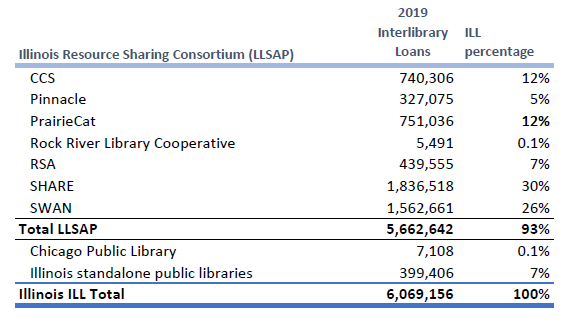
If there was no ability to easily lend material between libraries via the LLSAP, the local library would have to either acquire that material or forego the purchase. Assuming the average item purchase price is $20, the total amount 5,622,642 in items loaned would be $112.5 million dollars.
Illinois library consortia address inequity
Illinois public library funding is derived 91% from local property taxes. Public libraries determine an amount of money they need to operate, and that total dollar amount is collected through the county treasurer through property taxes.
The troubling truth is that for some public libraries, the amount of tax dollars collected will fall far short of what is needed to run the library. Any public library receiving less than 10% of its requested funding is an immediate crisis for basic operations. Think of a local business surviving a 10% loss year after year.
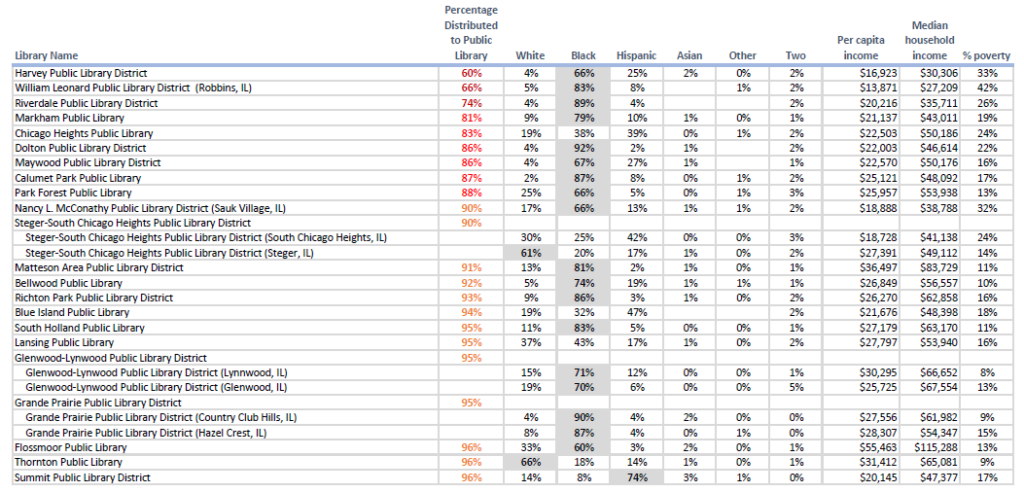
And if you look closely at the communities where the funding shortfall occurs, you will see this primarily impacts communities of color.
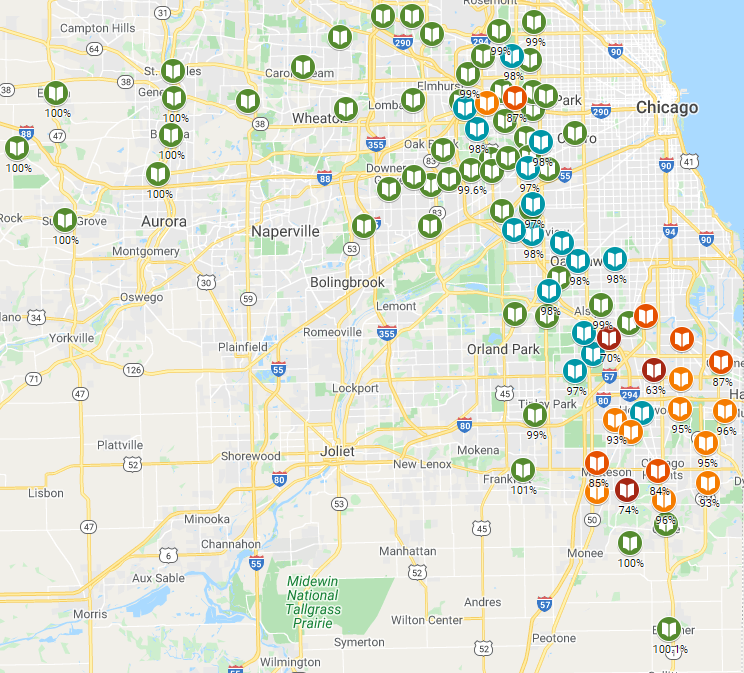
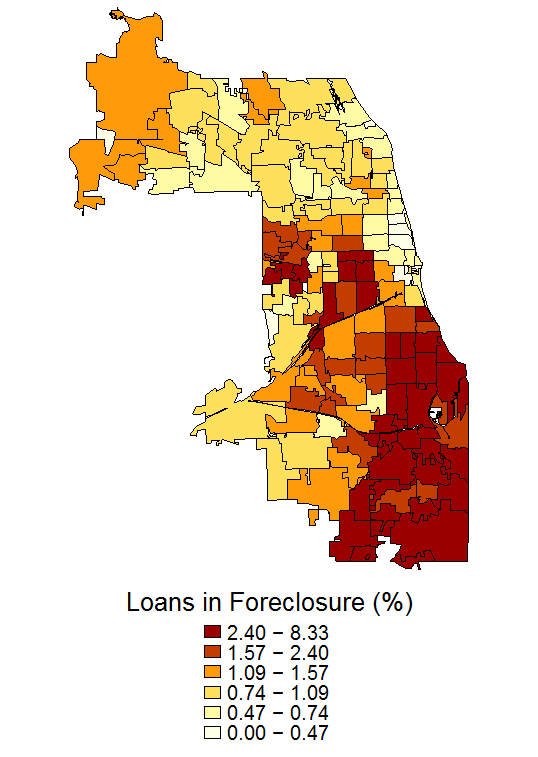

The Federal Reserve Bank of Chicago issued this foreclosure map for Cook County. The redlining in Chicagoland is available on this map created by the Home Owners Loan Corporation in 1940. Those libraries experiencing funding shortfalls are within those housing redlines, which is an established form of systematic racism in the United States that made it difficult or impossible for people in certain areas to access mortgage financing and thus become homeowners. [7]
The SWAN library consortium has 23 of its 100 member libraries under 97% funding. Yet, the same number of software and services are provided equally between SWAN members. The consortium has no service level tiers or add-on costs for participating libraries. The membership fee structure for public libraries is based on taxes distributed, so the libraries struggling with hardship due to a weak local tax base are factored within the cost to participate. Remarkably, within SWAN’s membership boundaries, resource sharing remains extremely high with those 23 libraries suffering funding shortfalls and the other libraries. Even during the two-years of global pandemic, interlibrary lending within SWAN has remained at 2019 levels.
Conclusion: Illinois library consortia serve a radical purpose
Illinois library consortia should not be viewed solely as a “hosted ILS” or a “shared catalog.” Consortia services provided to member libraries are distributed equally, without tiers or by ala carte expenses. The Illinois resource sharing consortia fill the missing role that county wide public libraries have within Ohio in bridging communities harmed by racial inequality.
The funding of library resource sharing consortium in Illinois should not only be maintained, but expanded, due to the huge cost savings and equitable access achieved through the alliance of participating libraries. The absence of the six LLSAP would result in $172 million total in additional expenses for the Illinois taxpayer.
Library resource sharing consortium fuse together altruism and fiscal stewardship. The willingness of expanding resource sharing among libraries fits perfectly alongside the tax dollar hawk in Illinois. Both constituents are rewarded through library collaboration at the library consortium level.
As a reminder, Illinois regional library systems are required to support LLSAP. The Illinois State Library defines the purpose of the regional library system as the following:
Illinois Library Systems are funded by annual system area and per capita grants from the Illinois State Library to serve the communities in their geographic area. This creates a network of cooperative library resource sharing accessible to Illinois residents. The key functions of the library systems include the administration of online consortial catalogs, known as Local Library System Automation Programs (LLSAPs), support for resource sharing and library system delivery service. [8]
There are three regional library systems in Illinois: Chicago Public Library System, Illinois Heartland Library System, and Reaching Across Illinois Library System. Within those library systems are the following seven LLSAP.
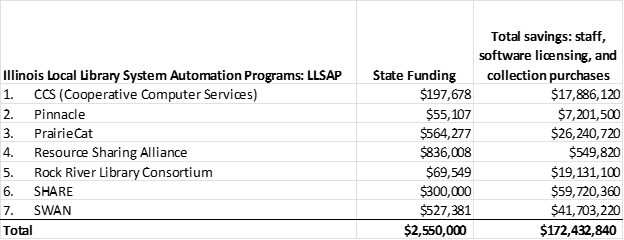
Please support the funding of the seven Illinois LLSAP and the expansion of funding for those entities. The state funding investment is nearly $172 million savings for taxpayers: around 70 times the total investment.
End notes:
- Library Consortia: Models for Collaboration and Sustainability, ALA Publishing, https://www.alastore.ala.org/content/library-consortia-models-collaboration-and-sustainability
- The Illinois Library and Information Network can be found on the Illinois Secretary of State’s Office website: https://www.ilsos.gov/departments/library/libraries/illinet.html
- The latest statistics available as of January 2022 encompasses the year prior to the global pandemic can be found online: https://imls.gov/research-tools/data-collection
- IMLS population data per public library in FY2019 has LLSAPs a 6,715,463 service population of 11,730,170 IMLS Illinois total. Chicago Public Library service population is 2,695,598 representing 23% of the total for Illinois.
- The expenses of standalone public libraries Glenside, Roselle, and Warrenville included Library Vendor Annual Maintenance (Innovative Polaris, Sierra, SirsiDynix, etc.), Hosting/SaaS of Library Services Platform, Enhanced Content Subscription (Content Café, Syndetic, etc.), OCLC annual subscription, Authority Service Updates (MARCIVE, vendor, etc.), EBSCO Discovery Service, EBSCO Novelist Select, Proxy Service (OCLC Ezproxy, OpenAthens, etc.), Mobile app (Capira, Boopsie, library vendor provided, etc.), Server Licensing (on-premise server support maintenance, warranty, etc.), Notice printing cost (postage, Unique Management MessageBee, local supplies, etc.), Patron notification via Text (Shoutbomb, etc.), Patron notification via Automated Telephony (local on-premise, Unique Management service, etc.), Library staff supporting ILS (salary, benefits, etc.), Cost spent attending vendor user event (Innovative Users Group, COSUGI, etc.)
- Assumes cataloging position is $50,000 annually.
- See SWAN tax analysis on Google Maps: https://www.google.com/maps/d/edit?hl=en&mid=13icXfJDPR3WHXJKY7EFJqim02h1ZPGUu&ll=41.74854858620986%2C-88.25241121577699&z=10
- https://www.ilsos.gov/departments/library/libraries/libsystems.html
Leave a Reply